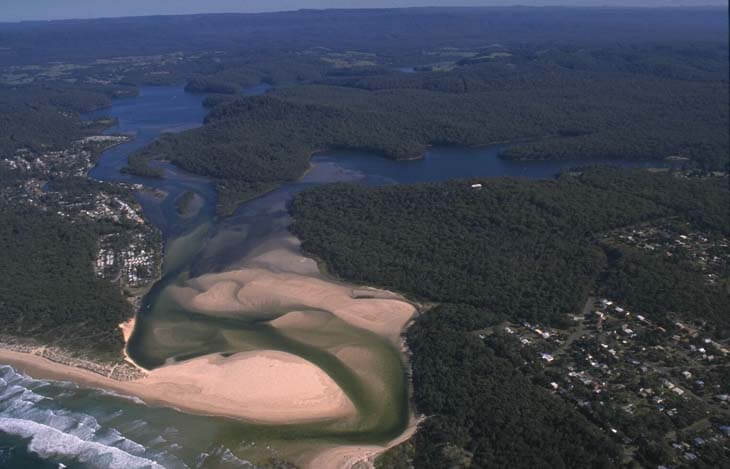Conjola Lake is located on the south coast of New South Wales north of Ulladulla. It is classed as a lake, with an entrance intermittently closed to the ocean. The entrance is occasionally opened artificially when water height exceeds a trigger level at which surrounding infrastructure is at risk of inundation.
Conjola Lake is relatively deep and largely surrounded by bushland. It is a scenic and popular destination for many holiday makers as well as a focal point for local communities.
Water quality report card
As part of our water quality monitoring program we assess the water quality and ecosystem health of an estuary using a range of relevant indicators. We sample a subset of the estuaries between Wollongong and the Victorian border every 3 years. The most recent sampling in Conjola Lake was completed over the 2019–20 summer, when 2 sites were sampled on a monthly basis.
This report card represents 2 water quality indicators that we routinely measure: the amount of algae present and water clarity. Low levels of these 2 indicators equate with good water quality.
Algae
Water clarity
Overall grade
The report card shows the condition of the estuary was good with:
- algae abundance graded fair (C)
- water clarity graded excellent (A)
- overall estuary health graded good (B).
Grades for algae, water clarity and overall are represented as:
- A – excellent
- B – good
- C – fair
- D – poor
- E – very poor.
Go to estuary report cards to find out what each grade means, read our sampling, data analysis and reporting protocols, and find out how we calculate these grades.
Shoalhaven City Council routinely monitors water quality in Lake Conjola and provides data from this monitoring on its online data portal.
We have monitored water quality in Conjola Creek since 2008. This table shows the water quality grades for this estuary over that time.
| Year | Algae | Water clarity | Overall grade |
|---|---|---|---|
| 2008–09 | A | A | A |
| 2017–18 | A | A | A |
Physical characteristics
| Estuary type | Lake |
|---|---|
| Latitude | –35.27 (ºS) |
| Longitude | 150.51 (ºE) |
| Catchment area | 139.1 km2 |
| Estuary area | 6.7 km2 |
| Estuary volume | 26,798.7 ML |
| Average depth | 4 m |
Tidal exchange volume
Tidal exchange volume or tidal prism data is available for this estuary. This tidal prism was measured in 2005.
| Tide state | Flow (ML) | Local tidal range (m) | Sydney Harbour tidal range (m) |
|---|---|---|---|
| Ebb flow | 1,470 | 0.64 | 1.26 |
| Flood flow | 1,750 | 0.67 | 1.06 |
Notes: km2 = square kilometres; m = metres; m3 = cubic metres; ML = megalitres.
Water depth and survey data
Bathymetric and coastal topography data for this estuary are available in our data portal.
Land use
The catchment of Conjola Lake is relatively undisturbed, with 85% remaining as forest, including areas of Conjola and Morton national parks. Urban and rural residential areas associated with Fishermans Paradise, Conjola Park, Lake Conjola and Yatte Yattah occupy about 10% of the catchment.
National and marine parks
- The largest conservation area in the Conjola Lake catchment is Morton National Park. The smaller Conjola National Park fringes the northern shoreline of the estuary.
- There is no marine park associated with this estuary.
Citizen science projects
- The South Coast Shorebird Recovery Program provides the opportunity for people to get involved in the protection and recovery of shore birds.
- The Budawang Coast Nature Map is an online data platform the community can use to record and identify biodiversity. Data collected is used to map the distribution of native plant and animal species from Moruya up almost to Kiama.
Community involvement
- Shoalhaven City Council’s Bushcare webpage supports a range of active groups in and around this catchment, including the Lake Conjola Bushcare Group.

Aerial view of Conjola Lake
Local government management
Local councils manage estuaries within their area unless the estuary is attached to a marine park. Shoalhaven City Council manages this estuary.
Threatened species
The large sandy area around the entrance of this estuary is a popular breeding ground for many threatened shorebirds such as the endangered little tern.
Read more about the biodiversity in our estuaries.